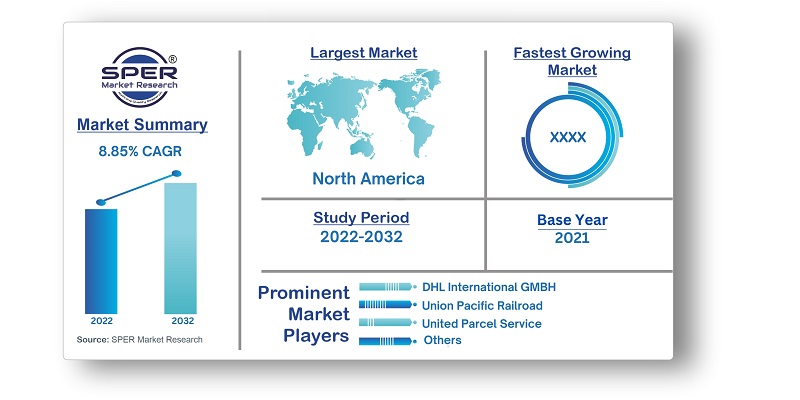
Third-Party Logistics Market Growth, Size, Trends, Scope, Revenue, Challenges and Future Outlook
Third-Party Logistics Market Size- By Services, By Transportation, By End User- Regional Outlook, Competitive Strategies and Segment Forecast to 2032
| Published: Mar-2023 | Report ID: AMIN2356 | Pages: 1 - 236 | Formats*: |
| Category : Automotive & Transportation | |||
- Globalization: As business and commercial operations become more globalized, organizations are expanding their reach into new markets and locations. To navigate complex worldwide networks, this expansion necessitates efficient supply chain management and logistical skills. 3PL suppliers provide the knowledge and infrastructure required to support worldwide trade, making them a crucial partner for enterprises developing globally.
- Supply Chain Complexity: Due to variables such as diverse suppliers, worldwide sourcing, just-in-time manufacturing, and consumer expectations for quick delivery, modern supply networks have become increasingly complex. Managing these complexity necessitates the use of specialist knowledge and resources. 3PL suppliers provide end-to-end supply chain solutions, which include integrating various components, optimizing inventory levels, and enhancing supply chain visibility, resulting in simpler operations and more customer satisfaction.


| Report Metric | Details |
| Market size available for years | 2019-2032 |
| Base year considered | 2021 |
| Forecast period | 2022-2032 |
| Segments covered | By Services, By Transportation, By End User. |
| Regions covered | Asia-Pacific, Europe, Middle East and Africa, North America, Latin America |
| Companies Covered | C.H. Robinson Worldwide, Inc., DB Schenker, DHL International GMBH, FedEx Corporation, KUEHNE+NAGEL Inc., Maersk, Nippon Express, Panalpina World Transport Ltd., Union Pacific Railroad, United Parcel Service. |
- Natural Gas Suppliers
- Industrial and Commercial Users
- Remote and Off-grid Locations
- Energy Utilities
- Renewable Energy Integration
| By Engine Type: |
|
| By Ship Type: |
|
| By Fuel Type: |
|
| By Services: |
|
| By Transportation: |
|
- Global Third-Party Logistics Market Size (FY’2022-FY’2032)
- Overview of Global Third-Party Logistics Market
- Segmentation of Global Third-Party Logistics Market By Services (Dedicated Contract Carriage (DCC)/Freight forwarding, Domestic Transportation Management (DTM), International Transportation Management (ITM), Warehousing & Distribution (W&D), Value Added Logistics Services (VALs))
- Segmentation of Global Third-Party Logistics Market By Transportation (Roadways, Railways, Waterways)
- Segmentation of Global Third-Party Logistics Market By End User (Manufacturing, Retail, Healthcare, Automotive, Others)
- Statistical Snap of Global Third-Party Logistics Market
- Expansion Analysis of Global Third-Party Logistics Market
- Problems and Obstacles in Global Third-Party Logistics Market
- Competitive Landscape in the Global Third-Party Logistics Market
- Effects of COVID-19 and demonetization on Global Third-Party Logistics Market
- Details on Current Investment in Global Third-Party Logistics Market
- Competitive Landscape of Global Third-Party Logistics Market
- Prominent Players in the Global Third-Party Logistics Market
- SWOT Analysis of Global Third-Party Logistics Market
- Global Third-Party Logistics Market Future Outlook and Projections (FY’2022-FY’2032)
- Recommendations from Analyst
1.1. Scope of the report1.2. Market segment analysis
2.1 Research data source2.1.1 Secondary data2.1.2 Primary data2.1.3 SPER’s internal database2.1.4 Premium insight from KOL’s2.2 Market size estimation2.2.1 Top-down and Bottom-up approach2.3 Data triangulation
4.1. Driver, Restraint, Opportunity and Challenges analysis4.1.1 Drivers4.1.2 Restraints4.1.3 Opportunities4.1.4 Challenges4.2. COVID-19 Impacts of the Global Third-Party Logistics Market
5.1. SWOT analysis5.1.1 Strengths5.1.2 Weaknesses5.1.3 Opportunities5.1.4 Threats5.2. PESTEL analysis5.2.1 Political landscape5.2.2 Economic landscape5.2.3 Social landscape5.2.4 Technological landscape5.2.5 Environmental landscape5.2.6 Legal landscape5.3. PORTER’S five forces analysis5.3.1 Bargaining power of suppliers5.3.2 Bargaining power of Buyers5.3.3 Threat of Substitute5.3.4 Threat of new entrant5.3.5 Competitive rivalry5.4. Heat map analysis
6.1 Global Third-Party Logistics Manufacturing Base Distribution, Sales Area, Product Type6.2 Mergers & Acquisitions, Partnerships, Product Launch, and Collaboration in Global Third-Party Logistics Market
7.1 Dedicated Contract Carriage (DCC)/Freight forwarding7.2 Domestic Transportation Management (DTM)7.3 International Transportation Management (ITM)7.4 Value Added Logistics Services (VALs)7.5 Warehousing & Distribution (W&D )
8.1 Railways8.2 Roadways8.3 Waterways
9.1 Automotive9.2 Healthcare9.3 Manufacturing9.4 Retail9.5 Others
10.1 Global Third-Party Logistics Market Size and Market Share by Region (2019-2025)10.2 Global Third-Party Logistics Market Size and Market Share by Region (2026-2032)10.3 Asia-Pacific10.3.1 Australia10.3.2 China10.3.3 India10.3.4 Japan10.3.5 South Korea10.3.6 Rest of Asia-Pacific10.4 Europe10.4.1 France10.4.2 Germany10.4.3 Italy10.4.4 Spain10.4.5 United Kingdom10.4.6 Rest of Europe10.5 Middle East and Africa10.5.1 Kingdom of Saudi Arabia10.5.2 United Arab Emirates10.5.3 Rest of Middle East & Africa10.6 North America10.6.1 Canada10.6.2 Mexico10.6.3 United States10.7 Latin America10.7.1 Argentina10.7.2 Brazil10.7.3 Rest of Latin America
11.1. C.H. Robinson Worldwide, Inc.11.1.1 Company details11.2.1 Financial outlook11.3.1 Product summary11.4.1 Recent developments11.2. DB Schenker,11.1.2 Company details11.2.2 Financial outlook11.3.2 Product summary11.4.2 Recent developments11.3. DHL International GMBH,11.1.3 Company details11.2.3 Financial outlook11.3.3 Product summary11.4.3 Recent developments11.4. FedEx Corporation11.1.4 Company details11.2.4 Financial outlook11.3.4 Product summary11.4.4 Recent developments11.5. KUEHNE+NAGEL Inc.11.1.5 Company details11.2.5 Financial outlook11.3.5 Product summary11.4.5 Recent developments11.6. Maersk11.1.6 Company details11.2.6 Financial outlook11.3.6 Product summary11.4.6 Recent developments11.7. Nippon Express,11.1.7 Company details11.2.7 Financial outlook11.3.7 Product summary11.4.7 Recent developments11.8. Panalpina World Transport Ltd.11.1.8 Company details11.2.8 Financial outlook11.3.8 Product summary11.4.8 Recent developments11.9. Union Pacific Railroad11.1.9 Company details11.2.9 Financial outlook11.3.9 Product summary11.4.9 Recent developments11.10. United Parcel Service11.1.10 Company details11.2.10 Financial outlook11.3.10 Product summary11.4.10 Recent developments
SPER Market Research’s methodology uses great emphasis on primary research to ensure that the market intelligence insights are up to date, reliable and accurate. Primary interviews are done with players involved in each phase of a supply chain to analyze the market forecasting. The secondary research method is used to help you fully understand how the future markets and the spending patterns look likes.
The report is based on in-depth qualitative and quantitative analysis of the Product Market. The quantitative analysis involves the application of various projection and sampling techniques. The qualitative analysis involves primary interviews, surveys, and vendor briefings. The data gathered as a result of these processes are validated through experts opinion. Our research methodology entails an ideal mixture of primary and secondary initiatives.



Frequently Asked Questions About This Report
PLACE AN ORDER
Year End Discount
Sample Report
Pre-Purchase Inquiry
NEED CUSTOMIZATION?
Request CustomizationCALL OR EMAIL US
100% Secure Payment






Related Reports
Our Global Clients
Our data-driven insights have influenced the strategy of 200+ reputed companies across the globe.




















